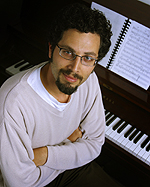|
MUSICOLOGY
Scholar exploring how Thelonious
Monk became part of jazz history
11/1/02
 |
|
Photo by Bill Wiegand
|
| Illinois musicologist Gabriel Solis is interested in
the "reception history" of jazz great Thelonious Monk and
his music. |
|
CHAMPAIGN, Ill. — Countless articles and books have been written
about legendary jazz pianist and composer Thelonious Monk, and the ink
is still flowing. In fact, says jazz music scholar Gabriel Solis, 20
years after Monk’s death, "He continues to be written about and talked
about incessantly."
Solis, a professor of musicology at the
University of Illinois at Urbana-Champaign, is among those contributing
to the nonstop buzz. But the focus of Solis’ work is what distinguishes
him from the pack. His work is not biographical; nor does it explore
the origins of the music itself from the moment of creation. Instead,
it’s about what Solis calls the "reception history" of Monk and his
music.
"I’m interested to find out how Monk went from being part of the jazz
scene to part of jazz history, and to look at what historians, fans
and critics have done with him since about 1974, when he stopped playing
and went into seclusion," Solis said. His article, "Hearing Monk: History,
Memory and the Making of a ‘Jazz Giant,’ " is scheduled for publication
in the forthcoming issue of The Musical Quarterly. He also is completing
a book on contemporary performances of Monk’s music, tentatively titled
"Monk’s Music: Thelonious Monk and Jazz History in the Making."
To better grasp what the "Jazz Giant" means to musicians today, Solis
collected oral histories from musicians who played with Monk, as well
as from contemporary jazz artists who perform his compositions today
and claim him as a significant influence on their own musical careers.
"So many people say Monk was ‘influential,’ but I wanted to break it
down," Solis said. "The article is specifically about the question,
‘What do you hear in this music?’ The most interesting thing," Solis
said, "is that many, many people did not talk about technical details
of his music – and there are lots of idiosyncratic details they could’ve
focused on, like his use of whole-tone saturated harmonics and characteristic
riffs. It wasn’t that. They almost always reacted in human terms: ‘He
was a humorous person’; or, ‘He stood up for himself and for his ideas.’
They’d say, ‘Keeping his music alive was to do my own thing.’
"But the musical thing is very much in there, too," Solis said. "Generally,
you find things in the music that match up." For instance, people who
knew Monk often mentioned his sense of humor, playfulness and ability
to find fun everywhere. And that was evident in his music, Solis said.
"Often there is something in his phrasing or the juxtapositioning of
his phrasing that makes you laugh."
Another common denominator that emerged from the interviews, Solis said,
was the perception that "Monk created a world."
"This is of interest," Solis wrote in his article, "because it is not
commonplace; it sets Monk apart from other musicians by virtue of having
created more than an individual voice, rather having built a separate
whole space for discourse. Entering into conversation within this world
is seen as requiring a major effort beyond that needed to converse within
the broader jazz world."
|
